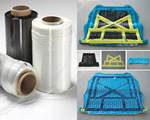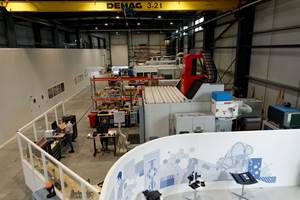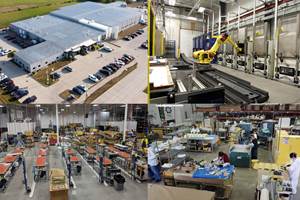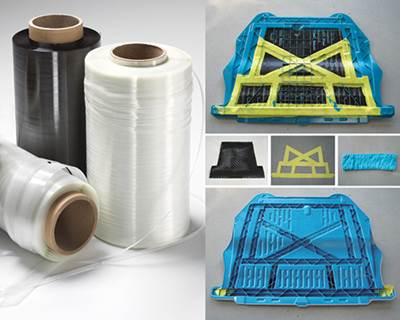Evolution of tailored D-LFT
In the past two decades, two competing composite technologies — sheet-form glass-mat thermoplastic (GMT) and pelletized long-fiber thermoplastic (LFT) — led to the development of a new form of glass-reinforced thermoplastic composite.
In the late 1990s and early 2000s two competing composite technologies — sheet-form glass-mat thermoplastic (GMT) and pelletized long-fiber thermoplastic (LFT) — led to the development of a new form of glass-reinforced thermoplastic composite.
GMT producers had been working since the 1980s to enhance the moldability of continuously reinforced, randomly oriented GMT composites, which were processed via compression molding. GMTs were very tough and relatively stiff, and they had less mass and could be processed faster than the thermoset sheet-molding compound (SMC) and metals that they commonly competed against. But as a semifinished good, traditional GMT was still costly and heavier than injection molded thermoplastics and posed significant challenges for molders who needed to fill intricate design features. The primary problem was glass bridging, which led to resin-rich areas that tended to fail before the rest of the part.
To address molding and filling issues, GMT producers experimented with discontinuous chopped-fiber products. They eventually phased out traditional continuous, randomly oriented fiber forms and settled on products whose fiber lengths (going into the tool) were on the order of 50 to 100 mm (1.97 to 3.94 inches). In situations that demanded greater stiffness and strength, their properties were further enhanced through the addition of sheets or blanks of unidirectional (UD) or fabric-reinforced GMT. This improved moldability and made GMT malleable enough for complex geometries. It also reduced cost and mass in applications where higher performance wasn't necessary, and that made the products more competitive against the rising tide of long-fiber thermoplastics.
Parallel to developments in GMT, producers of injection molded thermoplastics had been searching for ways to increase fiber length and fiber-volume fraction (FVF) to boost mechanical performance. The goal was to produce parts that could compete better in more structural applications without sacrificing the processing speeds, surface finish and finished part complexity that characterize injection molded thermoplastics.
Gradually, the glass length in precompounded resin pellets increased to 13 mm/0.51 inch, which was the maximum size that could be accommodated by the feed throat on the compounding unit of the injection molding machine. Longer fibers not only broke, but also tended to clog the equipment. In an effort to get around these limitations, inline compounding (ILC) was developed. ILC combines resin and additives at the press and brings them together with continuous-glass reinforcement (fed from large spools). The combined resin, additive and fiber mixture is immediately cut into a log or charge that is subsequently placed (manually or automatically) into an injection press and formed into parts. Later, ILC was combined with compression molding presses as well.
As GMT suppliers gave up strength and stiffness to enhance moldability and reduce mass and cost by using shorter fibers, and as injection molders sought greater strength and stiffness by incorporating longer fibers at higher fiber volumes, ILC was a technological meeting point that facilitated the direct long-fiber thermoplastics (D-LFT) process, which typically features fibers that are 20 to 40 mm/0.8 to 1.6 inches prior to molding. Further work with compression molding grades of these materials borrowed a technique from GMT producers by laying in additional blanks or charges of continuous-fiber-reinforced forms of composite with the same matrix. The technique of combining discontinuous with continuous reinforcements was developed in Europe, primarily for the automotive industry, and became known as tailored D-LFT.
Related Content
Plant tour: Daher Shap’in TechCenter and composites production plant, Saint-Aignan-de-Grandlieu, France
Co-located R&D and production advance OOA thermosets, thermoplastics, welding, recycling and digital technologies for faster processing and certification of lighter, more sustainable composites.
Read MorePlant tour: Sekisui Aerospace, Orange City, Iowa, Renton and Sumner, Wash., U.S.
Veteran composites sites use kaizen and innovation culture to expand thermoplastic serial production, 4.0 digitization and new technology for diversified new markets.
Read MoreUpdate: THOR project for industrialized, recyclable thermoplastic composite tanks for hydrogen storage
A look into the tape/liner materials, LATW/recycling processes, design software and new equipment toward commercialization of Type 4.5 tanks.
Read MoreCombining multifunctional thermoplastic composites, additive manufacturing for next-gen airframe structures
The DOMMINIO project combines AFP with 3D printed gyroid cores, embedded SHM sensors and smart materials for induction-driven disassembly of parts at end of life.
Read MoreRead Next
Hybrid thermoplastic molding: Toughening automotive composites
Tailored D-LFT with continuous and discontinuous glass offers best combination of strength, moldability.
Read MoreCeramic matrix composites: Faster, cheaper, higher temperature
New players proliferate, increasing CMC materials and manufacturing capacity, novel processes and automation to meet demand for higher part volumes and performance.
Read MoreNext-gen fan blades: Hybrid twin RTM, printed sensors, laser shock disassembly
MORPHO project demonstrates blade with 20% faster RTM cure cycle, uses AI-based monitoring for improved maintenance/life cycle management and proves laser shock disassembly for recycling.
Read More.jpg;width=70;height=70;mode=crop)












